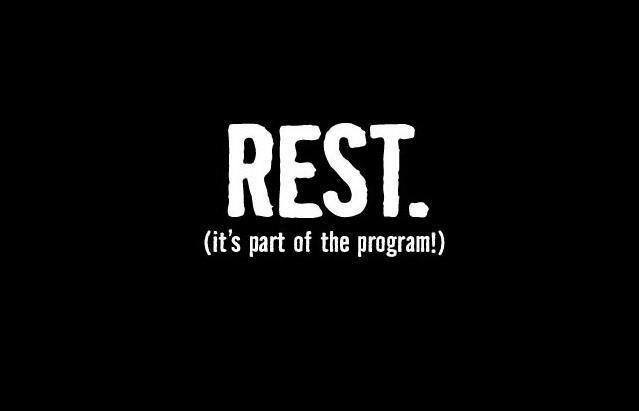You just watched a promo video from the official CrossFit YouTube page. It’s pretty inspiring isn’t it? I mean, in a world where people will actually buy a Shake Weight, or think that a soy latte is a great post-workout meal after Hot Yoga, it’s nice to see a brand/culture promoting some give-it-all-you’ve-got training. The intense level of training desired and promoted by CrossFit is based on their idea of GPP, or General Physical Preparedness. In their words, “Our fitness, being “CrossFit”, comes through molding men and women that are equal parts gymnast, Olympic weightlifter weightlifter, and multi-modal sprinter or “sprintathlete.” Develop the capacity of a novice 800-meter track athlete, gymnast, and weightlifter and you’ll be fitter than any world-class runner runner, gymnast, or weightlifter weightlifter.” (Those words are from an issue of CrossFit Journal in which founder Greg Glassman discusses the basic tenets of fitness. You can read it HERE if you wish.)
“CrossFit makes use of three dif different ferent standards or models for evaluating and guiding fitness. Collectively Collectively, these three standards define the CrossFit view of fitness. The first is based on the ten general physical skills widely recognized by exercise physiologists. The second standard, or model, is based on the performance of athletic tasks, while the third is based on the ener energy systems that gy drive all human action.” Those ten general physical skills are:
- Cardiovascular/respiratory endurance – The ability of body systems to gather, process, and deliver oxygen.
- Stamina – The ability of body systems to process, deliver, store, and utilize energy.
- Strength – The ability of a muscular unit, or combination of muscular units, to apply force.
- Flexibility – the ability to maximize the range of motion at a given joint.
- Power – The ability of a muscular unit, or combination of muscular units, to apply maximum force in minimum time.
- Speed – The ability to minimize the time cycle of a repeated movement.
- Coordination – The ability to combine several distinct movement patterns into a singular distinct movement.
- Agility – The ability to minimize transition time from one movement pattern to another another.
- Balance – The ability to control the placement of the bodies center of gravity in relation to its support base.
- Accuracy – The ability to control movement in a given direction or at a given intensity intensity.
The most concise definition of CrossFit’s view of Fitness is titled “World-Class Fitness in 100 Words“, and you’re about to read it:
- Eat meat and vegetables, nuts and seeds, some fruit, little starch and no sugar sugar. Keep intake to levels that will support exercise but not body fat.
- Practice and train major lifts: Deadlift, clean, squat, presses, C&J, and snatch. Similarly, master the basics of gymnastics: pull-ups, dips, rope climb, push-ups, sit-ups, presses to handstand, pirouettes, flips, splits, and holds. Bike, run, swim, row row, etc, hard and fast.
- Five or six days per week mix these elements in as many combinations and patterns as creativity will allow allow. Routine is the enemy. Keep workouts short and intense.
- Regularly learn and play new sports.
I really like that! I mean, in 100 words, they cover the basics of nutrition, exercise selection, frequency, and physical activity in general. It’s not the equivalent of reading textbooks, getting certified, or earning a degree, but it sure packs a great deal of information into 100 words. This vagueness probably leads to some of the issues that arise from CrossFit.
The random nature of CrossFit workouts may in fact be it’s largest problem. Some people may be fans of walking into their gym unsure of what the Workout of the Day will be, but I’m not a fan. I think it’s foolhardy for several reasons, among them the risk of orthopedic injury, the utter lack of periodization in any sense, and the importance of mental preparation for a training session.
The ‘big’ lifts are also the ‘technical’ lifts, and a level of skill needs to be developed with each movement prior to the execution of high intensity (% of 1RM) or high volume (sets x reps) training. The very exercises that CrossFit explains on their website (which I listed above), are the same exercises that require proficient technique to dabble in, and near-perfect technique to master. Now’s a good time to make a joke about the competitive Olympic Weightlifters training twice or more per day for years and still not being perfect. You think that learning once with a PVC pipe or 5lb training plates is going to magically make you a good snatcher? Hell no! Unfortunately, plenty of people go from the Pipe to a (fairly) heavy barbell over the course of a few days, before they have any sound technique to work with and before they’ve experienced and physiological adaptations to the activity. I’m a huge fan of the power lifts and Olympic lifts for develeping strength and power, but it’s foolish to use highly technical exercises for high volume, timed sets.
The lack of periodization in CrossFit can also lead to orthopedic injuries, due to overuse. I’m a fan of exercise and equipment variety to keep things fresh, but haphazardly choosing exercises can beat you up pretty bad. While I’m sure that there is some effort taken by CrossFit to balance out the potential risk of their training practices, let’s look at the past few Workout of the Day(s):
Tuesday 110823
Five rounds for time of:
40 Double-unders
30 Box jumps, 24 inch box
20 Kettlebell swings, 1.5 pood
Monday – Rest
Sunday 110821
Shoulder Press 5-5-5-5-5 reps
Saturday 110820
Three rounds for time of:
12 Muscle-ups
75 Squats
Friday 110819
“Isabel“
For time:
Snatch 135 pounds, 30 reps
Use 95 pounds, 65 pounds or broomstick as needed.
If you’re following these WOD’s, I’m pretty sure you just about hate your shoulders after snatching, muscle-upping, and pressing 3 days in a row. Either that, or you just think you’re a badass for being “CrossFit”, and take a Tylenol to make things better. While there’s no such thing as perfect periodization, it’s important to balance out training stimulus and recovery time, as well as provide a balance between each workout in a given period of time, either day to day, or in a given week or month. Periodizing workouts to include recovery helps to ensure that progress is made in the long run, with minimized injury risk, instead of focusing on a short term goal that poses a much larger potential link.
I’m sure that by now it just sounds like I’m complaining about CrossFit, and I know that I am, even though I like the intent of the training program. I like the idea of developing well rounded fitness, of using basic movement patterns, strength/power exercises, and body weight exercises to do so, and to emphasize an athletic style of training over the typical crap we see in most commercial gyms. This list is some insight from Coach Glassman on the intent of CrossFit, from the CrossFit website:
“CrossFit is in large part derived from several simple observations garnered through hanging out with athletes for thirty years and willingness, if not eagerness, to experiment coupled with a total disregard for conventional wisdom. Let me share some of the more formative of these observations:
1. Gymnasts learn new sports faster than other athletes.
2. Olympic lifters can apply more useful power to more activities than other athletes.
3. Powerlifters are stronger than other athletes.
4. Sprinters can match the cardiovascular performance of endurance athletes even at extended efforts.
5. Endurance athletes are woefully lacking in total physical capacity.
6. With high carb diets you either get fat or weak.
7. Bodybuilders can’t punch, jump, run, or throw like athletes can.
8. Segmenting training efforts delivers a segmented capacity.
9. Optimizing physical capacity requires training at unsustainable intensities.
10. The world’s most successful athletes and coaches rely on exercise science the way deer hunters rely on the accordion.”
I may not be intent on using his exact words, but for the most part I think it makes plenty of sense. (I’m going to specifically address that 10th intent in an upcoming post.) See, I like the intent of CrossFit, but I don’t like the execution. I think that it can be handled much better, specifically with coaches programming for individual clients/athletes, based on their assessments, injury history, overall exercise history, and personal factors. Sure, they may include the very same workouts as the person standing next to them, but designed in a way to maximize their fitness in the long term without compromising their body in the present time. Good idea in the head, but it got a little messed up when they tried to put it on paper.
For now, I think I went on a little too much about CrossFit, but I think you have a general sense of what it is, what it’s supposed to do, and what I don’t like about it. While I wouldn’t exactly recommend that people train exclusively with the Workout of the Day or the CrossFit method, I think that the athleticism and intensity is a step in the right direction in a culture that thinks that Zumba and Aquacise are going to help them reach their fitness or performance goals.
Let’s close up with this hilarious video that came out at the end of July that I think you’ll find pretty humorous. It summarizes things rather nicely.





Leave a reply to Jason Cancel reply